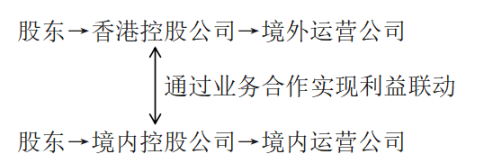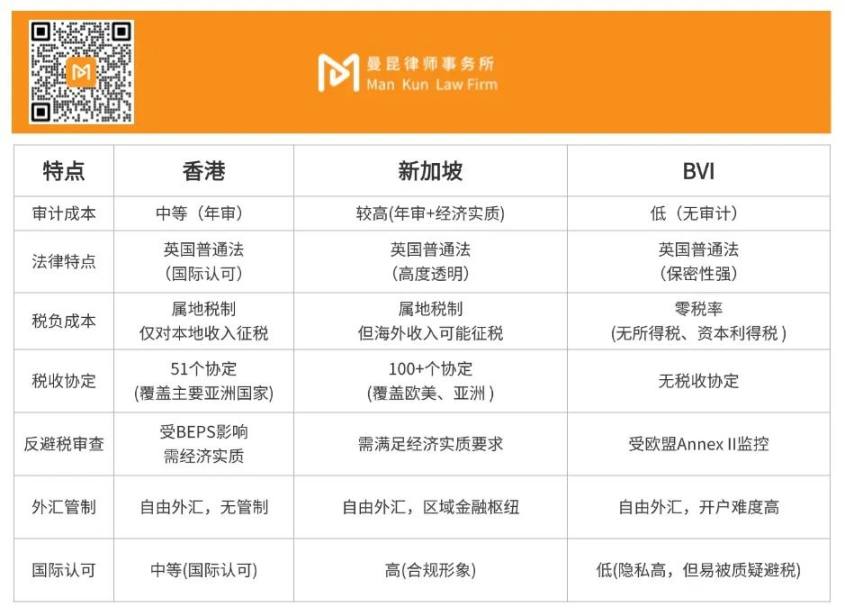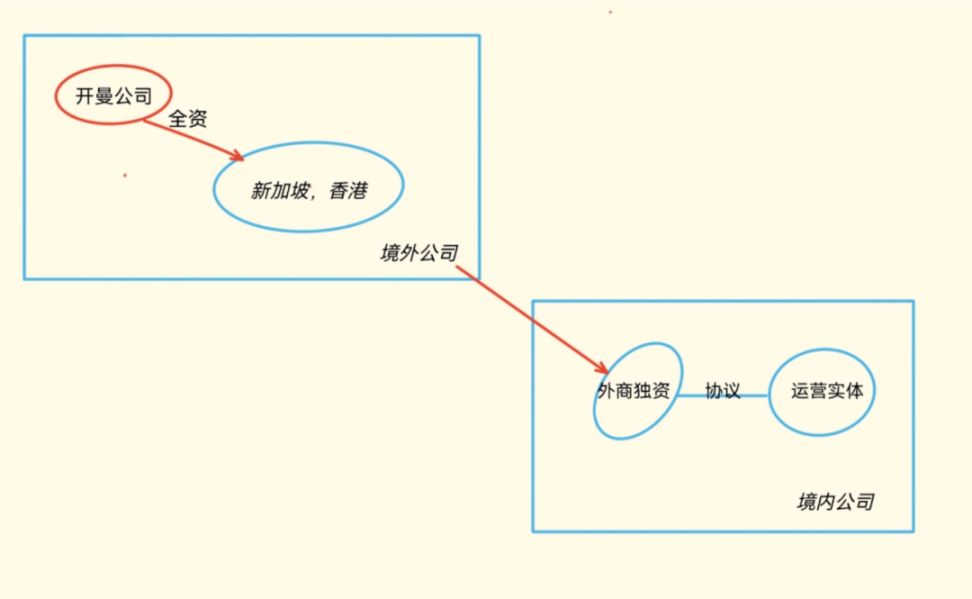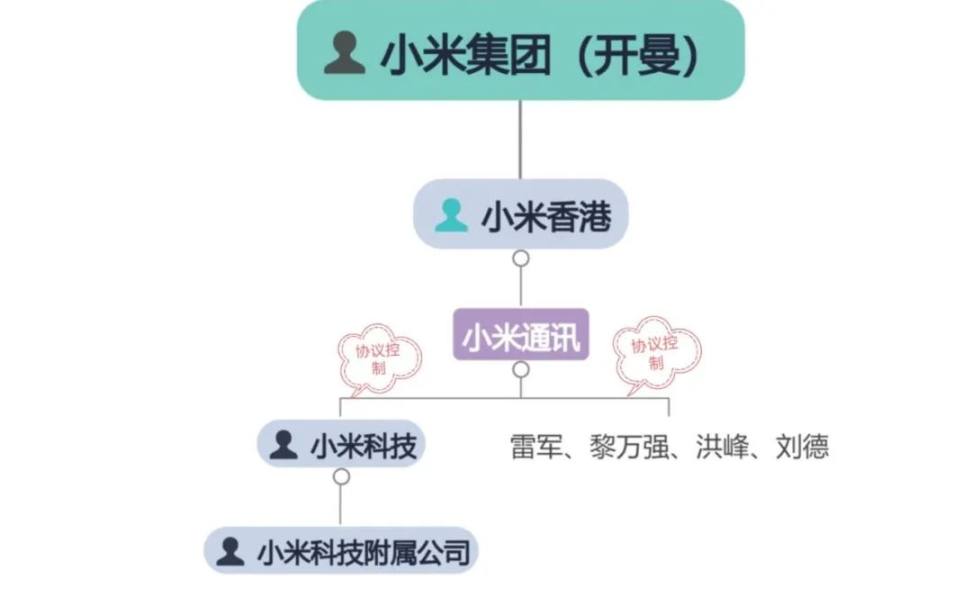With the globalization of Web3 projects, companies are shifting from a single architecture to a hybrid architecture to achieve risk isolation, capital flow, strategic collaboration, and tax planning.
Written by: Mankun
In today's wave of globalization, Web3 projects are moving to the international stage at an unprecedented speed, with Chinese companies being an undeniable force. However, the uncertainty of industry policies, the lack of legal frameworks, and the ambiguity of regulatory attitudes in China have caused hesitation in the development of Web3 enterprises. These factors collectively pose compliance challenges for Web3 projects in the domestic market, forcing many practitioners to turn overseas or seek breakthroughs within limited compliance frameworks. Nevertheless, by closely monitoring policy trends and leveraging favorable policies from various countries, it is still possible for the Web3 industry to find suitable development models.
Objectives of Companies Going Overseas
(1) Market Opportunities
The global market provides Web3 projects with a broader user base and growth potential. Particularly in regions like Asia and Europe, users have a higher acceptance of blockchain technology and cryptocurrencies, which brings more business opportunities and development space for projects.
(2) Regulatory Environment
Different countries have significantly different regulatory policies regarding blockchain and cryptocurrencies. Some countries, such as Singapore and Hong Kong, have relatively relaxed and friendly regulatory environments, providing greater flexibility and security for the operation and development of Web3 projects. In contrast, strict regulations in certain countries may limit project development. In some countries, Web3 projects may face legal and compliance challenges. Expanding to countries with more favorable legal environments can effectively reduce these risks and ensure the long-term stable operation of projects.
(3) Talent Acquisition
Web3 is a technology-intensive field, and attracting top developers and experts is crucial for the success of projects. By going overseas, projects can search for and recruit outstanding talent globally, accelerating the innovation and development of technology and products.
(4) Funding and Investment
Going overseas allows Web3 projects to access more potential investors and funding sources. Especially in regions where venture capital and cryptocurrency investments are active, such as the United States or Southeast Asia, projects find it easier to obtain financial support, driving rapid development.
(5) Industry Cluster Effect
Different countries and regions have formed various industry clusters due to inherent advantages in technology and policy, creating regional supply chains that provide different foundational support for local Web3 enterprises.
(6) Risk Diversification
Conducting business in multiple countries can disperse risks, avoiding significant impacts on projects due to economic, political, or regulatory changes in a single market, thereby enhancing the project's resilience.
Compliance and Risk Isolation
Web3 enterprises must prioritize the local regulatory framework when choosing overseas destinations to ensure legal and compliant operations.
(1) Compliance Policies of Various Countries and Regions
Hong Kong:
Since 2023, Hong Kong has implemented a licensing system for Virtual Asset Service Providers (VASP), requiring all virtual asset trading platforms (VATP) to obtain licenses from the Hong Kong Securities and Futures Commission (SFC). As of January 2025, the SFC has issued operational licenses to platforms such as PantherTrade and YAX, with a total of 7 licensed since mid-2024. Since 2020, Hong Kong has officially licensed 10 exchanges, including 4 in December 2024, demonstrating a cautious yet open attitude towards the virtual asset industry. Licensing requirements include strict KYC processes, asset protection, and cybersecurity measures aimed at protecting investors and preventing money laundering risks.
Singapore:
The Monetary Authority of Singapore (MAS) allows fintech companies to test innovative products in a controlled environment through a Regulatory Sandbox, providing regulatory support for enterprises. Coinbase's compliance layout in Singapore reflects its adaptation to the regulatory-friendly environment: it received In-Principle Approval from MAS in 2022 and further obtained a Major Payment Institution License in 2023. This indicates that Singapore has become a hub for Web3 enterprises in the Asia-Pacific region, with Coinbase establishing its Asia-Pacific institutional business there, showcasing confidence in the local regulatory environment.
Other Regions: Europe, Asia-Pacific, and North America:
The EU's Markets in Crypto-Assets Regulation (MiCA) will take effect at the end of 2024, standardizing the regulatory framework for crypto assets. MiCA requires crypto asset service providers to register and comply with standards for transparency, liquidity, and consumer protection.
In the Asia-Pacific region, Japan requires virtual asset service providers to obtain licenses from the Financial Services Agency (FSA), while Australia requires registration as a digital currency exchange service provider, regulated by the Australian Transaction Reports and Analysis Centre (AUSTRAC). In North America, the U.S. SEC has strict regulations on crypto assets, with companies like Binance and Coinbase facing lawsuits, yet they are actively communicating with regulators to seek a clear framework.
(2) Risk Isolation
The risk isolation mechanism is a crucial component of the compliance framework for Web3 projects in cross-border operations. Its core objective is to ensure that risks from different business segments or regions do not infect each other through reasonable design of the corporate structure, thereby protecting the overall stability and sustainability of the enterprise. In the globalized Web3 industry, where regulatory policies, legal environments, and market risks vary significantly across different jurisdictions, the risk isolation mechanism is particularly critical.
For example, establishing independent subsidiaries in different countries or regions, with each subsidiary acting as an independent legal entity responsible for business operations in specific markets. This can limit legal, financial, and operational risks to specific entities, preventing risk diffusion across the entire corporate group. Each entity operates independently without interference, so even if one region faces regulatory changes or legal challenges, other entities can continue to operate normally. This design not only enhances the enterprise's risk resilience but also facilitates strategy adjustments based on specific market demands.
Placing core assets (such as technology patents, intellectual property, brands, etc.) in specific holding companies or trust structures to protect them from the risks of operating entities. For instance, a company can register core assets in a holding company in the British Virgin Islands (BVI) or the Cayman Islands while placing high-risk operational businesses in subsidiaries in other regions. Even if the operating entity faces lawsuits or financial difficulties, core assets can still be protected, ensuring the long-term development of the enterprise.
Clearly defining the rights and obligations between entities through contracts and agreements to ensure effective legal isolation of risks. For example, companies can use service agreements, licensing agreements, or financial transaction agreements to delineate business boundaries and responsibilities between entities. This approach not only reduces the likelihood of risk transmission but also provides flexibility and transparency for enterprises in global compliance operations.
By reasonably establishing corporate structure isolation mechanisms, Web3 enterprises can flexibly respond to regulatory requirements and risk challenges in different markets, ensuring the safety of core business and assets while maintaining the stability of global operations.
Main Destinations for Chinese Companies Going Overseas
(1) Hong Kong
As an international financial center, Hong Kong has a mature financial infrastructure and a sound legal system, providing Web3 companies with a stable operating environment. Compared to other regions, Hong Kong has relatively relaxed regulations for Web3 projects, facilitating rapid business development for startups. In recent years, the Hong Kong government has actively promoted the development of blockchain technology, creating favorable conditions for Web3 companies through policy incentives and support measures.
(2) Singapore
Singapore is a leading fintech hub in Asia, with an advanced technology ecosystem that attracts a large number of Web3-related enterprises. The Singapore government maintains an open attitude towards blockchain and Web3 technologies and has established clear regulatory policies to help companies develop rapidly under compliance. Singapore's tax system is relatively favorable, reducing operational costs for Web3 companies and enhancing their attractiveness.
(3) BVI (British Virgin Islands)
The BVI is known for its fast and simple company registration process and low registration fees, making it suitable for Web3 startups to establish quickly. The BVI offers strict privacy protection policies to safeguard company and shareholder information, making it very suitable for privacy-focused Web3 projects. The local legal system is flexible and provides significant tax incentives, making it an ideal choice for offshore registration.
Constructing an Overseas Structure
The underlying logic of global compliance layout is to establish different entities to build a regional compliance framework, leveraging the unique advantages of each region through shareholding or substantial control. This approach transforms offshore companies from mere "regulatory evasion" or "tax havens" into "strategic hubs" for enterprises to construct a global compliance system and optimize the allocation of funds and resources through reasonable planning. Companies can flexibly build single-entity structures, multi-entity structures, parallel structures, and other multi-layered, multi-ecosystem corporate strategic systems based on the needs of different development stages to adapt to various scenarios and stages.
(1) Applicability of Structures
In terms of structural applicability, different corporate structure designs can meet the goals of enterprises at different development stages and business needs.
(1) Single-Entity Structure
A single-entity structure is suitable for startups or small companies that wish to quickly validate their business model and focus on a single market.
This structure is simple, with low management costs, making it easy to start and operate quickly. For example, a startup can register a single entity in Singapore to swiftly enter the market and enjoy local tax incentives while avoiding the complexities of cross-border management burdens.
However, as the company scales and business complexity increases, the shortcomings of a single-layer structure gradually become apparent. It may not meet the compliance requirements of global markets, such as the differences in regulatory standards across regions, and it is also challenging to achieve efficient resource allocation and effective risk isolation. When a company needs to enter multiple markets simultaneously, a single entity may face bottlenecks in taxation, legal, or operational aspects.
(2) Multi-Entity Structure
A multi-entity structure is suitable for enterprises with long business lines, complex segments, and diverse equity structures.
By establishing subsidiaries or affiliated companies in different jurisdictions, a multi-entity structure can achieve risk isolation, tax optimization, and market adaptation. For example, a technology company may set up a subsidiary in the EU to comply with GDPR (General Data Protection Regulation) requirements while establishing a holding company in the Cayman Islands to optimize its global tax structure. This structure controls legal and financial risks within specific regions by dispersing entities while enhancing the enterprise's operational flexibility globally. It supports resource allocation between different markets and enhances global competitiveness through a regional compliance framework.
It is suitable for enterprises that have entered the expansion stage and need to address multi-country regulatory environments and diversified business needs. For instance, some leading exchanges have established subsidiaries in Southeast Asia, Europe, and North America, launching different versions of their apps to adapt to local consumer habits and legal requirements.
(3) Parallel Structure
A parallel structure is another more complex design, typically involving the direct combination of multiple multi-entity structures in terms of equity or business, particularly suitable for enterprises that need to operate multiple business segments independently.
Parallel architecture ensures that various business segments operate independently in legal and financial terms by establishing multiple independent entities. For example, a group may simultaneously operate in manufacturing, retail, and financial services, creating independent legal entities for each segment through parallel architecture to prevent risks from one segment affecting others. However, through equity control or business integration, there can still be close connections and synergies between the segments. A Web3 company can independently operate technology development and business promotion in different regions, meeting local compliance requirements while optimizing global resource allocation.
This design not only enhances management clarity but also achieves greater flexibility and stability in global compliance layouts, making it more suitable for enterprises with diversified businesses.
(2) Analysis of Structural Advantages
(1) Single-Entity Structure
The characteristic of a single-entity structure is that enterprises can fully leverage the policy and regulatory advantages of the chosen jurisdiction to achieve rapid compliance and operation. The regulatory environment in different regions provides unique opportunities for enterprises.
For instance, if a company values financing or the technology cluster effect, it can choose Singapore as its registration location. Singapore's financing laws are relatively relaxed, especially open in capital markets and financial innovation. This provides Web3 enterprises with flexible financing channels, helping them quickly raise funds and promote project development. Additionally, the Singapore government actively encourages the development of high-tech enterprises, offering various policy supports and financial incentives. Companies can leverage these policies to reduce R&D costs and accelerate technological innovation.
If a company places more emphasis on tax and shareholder privacy, it can choose BVI as its registration location. BVI is known for its strict privacy protection policies, making it particularly suitable for Web3 enterprises that prioritize information security and shareholder rights protection. Companies registered here can enjoy high levels of business confidentiality protection while benefiting from simplified regulatory requirements and a low tax environment.
(2) Multi-Entity Structure
Case: China → Singapore → Domestic Company
The characteristic of a multi-entity structure is its ability to organically combine the regulatory advantages of different regions, optimizing compliance and operations by establishing subsidiaries or affiliated companies globally.
For example, a BVI holding company can hold a Hong Kong financial company, which in turn holds a domestic operating company. The BVI company benefits from low tax rates and privacy protection, the Hong Kong holding company enjoys financial conveniences and tax incentives in Hong Kong, and the operating company in China benefits from research-related subsidy policies and advantages in the technology industry, optimizing the global holding structure and protecting core assets.
Through a multi-entity structure, companies can flexibly allocate resources between different markets while controlling legal and financial risks within specific regions, ensuring compliant operations globally.
(3) Parallel Structure
For example:

The regulatory characteristic of parallel architecture lies in its high flexibility and risk isolation capability, making it particularly suitable for enterprises with group structures, diversified businesses, and complex equity needs.
For instance, by establishing multiple independent entities, parallel architecture ensures that various business segments do not interfere with each other legally and financially, preventing regulatory risks in one segment from affecting others. A Web3 enterprise may independently operate technology development and business promotion in different regions, meeting local compliance requirements while optimizing global resource allocation.
Although each entity operates independently, close connections and synergies can still be achieved between segments through equity control or business integration. A multinational company may establish a technology R&D center in Singapore and a Web3 service company in Hong Kong, with both collaborating through equity or business interactions to jointly promote technological innovation and market expansion.
Parallel architecture not only enhances the flexibility and stability of enterprises in global compliance layouts but also provides a solid foundation for sustainable development in complex regulatory environments.
Tax Advantages of Structures
When choosing the registration location for structural entities, it is essential to stay informed about local regulatory policies, technological needs, and cost-reduction requirements, as well as the depth of cooperation with local service providers and compliance services, especially regarding the tax distinctions and preferential agreements in various regions.
(1) Single-Entity Structure
A single-entity structure refers to enterprises conducting overseas investments or operations through a single offshore subsidiary, suitable for businesses that are concentrated, smaller in scale, or targeting a single market.
Advantages: Simple structure, convenient management and control.
Disadvantages: May face relatively high tax burdens and lack risk isolation mechanisms.

- Hong Kong: 8.25% tax rate on the first 2 million profits, with double taxation exemption benefits from over 50 countries.
Advantages: Corporate income tax (profits tax) of 8.25%-16.5% (halved for the first 2 million HKD profits), no capital gains tax or value-added tax, tax agreements with over 50 countries, free currency exchange, and convenient listing financing.
- Singapore: 17% tax rate, extensive bilateral tax treaty network.
Advantages: Corporate income tax of 17%, tax exemption for the first three years, bilateral tax agreements with over 100 countries, beneficial for cross-border tax avoidance.
- BVI: Zero tax haven with strong confidentiality.
Advantages: 0% corporate income tax, 0% value-added tax, 0% capital gains tax, extremely simplified company registration process, strong confidentiality of shareholder information.

(2) Multi-Entity Structure
Using a multi-entity structure allows for more effective tax planning. Domestic enterprises can establish one or more intermediate holding companies in low-tax countries or regions (usually Hong Kong, Singapore, BVI, or Cayman Islands) to invest in target investment countries. By leveraging the low tax rates and confidentiality of offshore companies, enterprises can reduce their overall tax burden while protecting company information, diversifying parent company risks, and facilitating future equity restructuring, sales, or listing financing.
Advantages: Can utilize tax incentives from various countries to lower investment costs and support global layout.
Disadvantages: Complex management, and tax compliance costs may increase.
- Top Level: High confidentiality + low tax rate + free capital flow.
Registration locations: Offshore financial centers such as Cayman Islands, British Virgin Islands (BVI).
Functionality: Shareholder and beneficiary information protected by law, avoiding single market risks (diversifying geopolitical impacts).
- Operational Level: Connecting top-level investors with bottom-level operating entities + enhancing investment returns + profit retention.
Registration location choices: Hong Kong / Singapore (trade compliance), Ireland / Netherlands (EU market), Dubai (Middle East market).
Functionality: Signing double taxation avoidance agreements (DTT) with target investment countries to enhance overall investment returns.
- Actual Operating Company: Business implementation + direct/indirect holding.
Registration location choices: Local companies in target markets.
Functionality: Implementing production, marketing, and localized services to meet local operational requirements, choosing registration locations based on business projects.

Case Study: Cross-Border E-commerce
Structural Design:
Holding Level: BVI Company (confidentiality) + Hong Kong Company (financing and supply chain coordination).
Operational Level: Hong Kong Company (offshore trade tax exemption) + Dubai Company (Middle East warehousing and logistics).
Entity Level: Mainland China factory (export tax rebate) + Brazilian subsidiary (localized sales).
By having the BVI company hold the Hong Kong company, which then reinvests in the operational layer, the offshore holding company controls the operating entity through a layered structure using VIE agreements.
The BVI company serves as the top-level holding entity, with dividends from Hong Kong to BVI exempt from withholding tax, and future equity transfers exempt from capital gains tax, protecting the founders' privacy.
Case Study: Xiaomi Group
Structural Design:
Holding Level: Xiaomi Group (Cayman Islands).
Operational Level: Xiaomi Hong Kong (global procurement + profit retention).
Entity Level: Xiaomi Communications (direct-to-consumer), Xiaomi Technology, and Xiaomi Technology subsidiaries.
Through Xiaomi Group (Cayman Islands) holding Xiaomi Hong Kong Company, which then reinvests in entities like Xiaomi Communications. Xiaomi Communications signs agreements with shareholders registered with Xiaomi Technology to control legal documents, using VIE agreements to control Xiaomi Technology and indirectly control Xiaomi Technology subsidiaries.

Conclusion
In the context of globalization, going overseas with Web3 projects has become a key strategy for Chinese enterprises to break through domestic regulatory restrictions and explore overseas markets. By going overseas, companies can not only effectively avoid compliance risks but also seize international market opportunities, attract quality resources, and achieve risk diversification. Regions like Hong Kong, Singapore, and BVI have become ideal destinations for Web3 enterprises due to their relaxed regulatory environments, tax incentives, and well-developed infrastructure.
In terms of structural design, companies can flexibly choose single-entity, multi-entity, or parallel structures based on their scale and objectives to ensure compliance and isolate potential risks. At the same time, leveraging the policy advantages of various regions, companies can optimize capital flow through multi-entity structures, significantly reducing tax burdens.
Looking ahead, as Web3 projects continue to globalize, companies are shifting from single structures to hybrid structures to achieve risk isolation, capital flow, strategic collaboration, and tax planning. By establishing multiple entities in different jurisdictions, companies can effectively isolate market risks and ensure compliance while utilizing offshore companies and holding structures to optimize capital flow, reduce tax burdens, and integrate global resources to enhance innovation capabilities and market competitiveness, seizing new opportunities brought by globalization for blockchain technology.
免责声明:本文章仅代表作者个人观点,不代表本平台的立场和观点。本文章仅供信息分享,不构成对任何人的任何投资建议。用户与作者之间的任何争议,与本平台无关。如网页中刊载的文章或图片涉及侵权,请提供相关的权利证明和身份证明发送邮件到support@aicoin.com,本平台相关工作人员将会进行核查。




